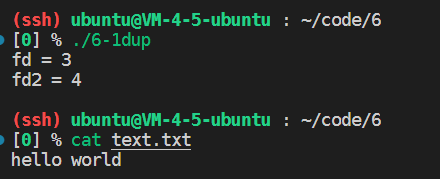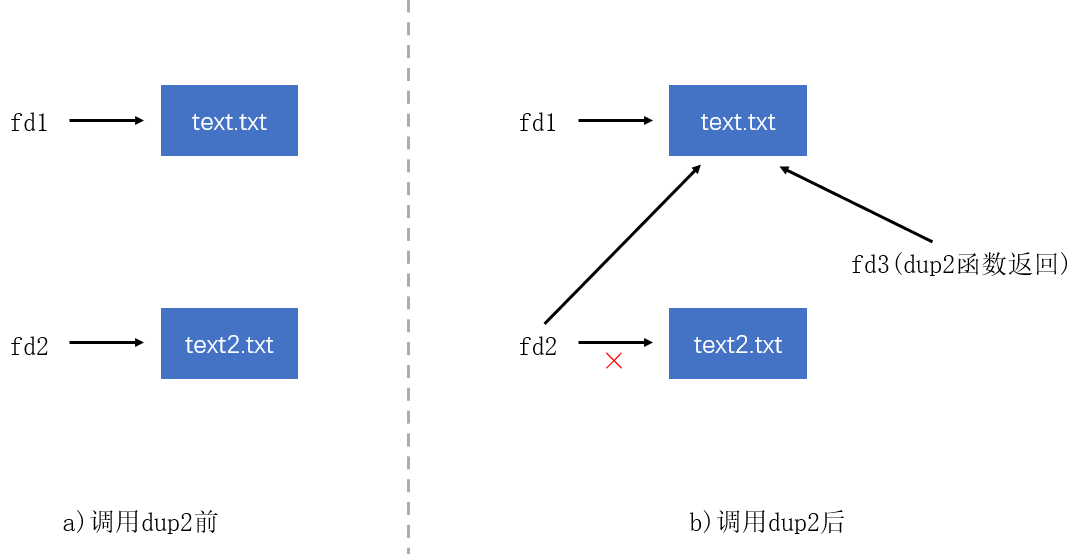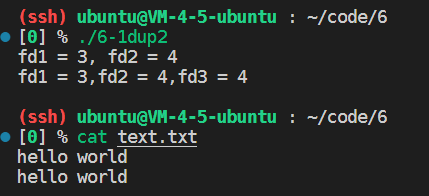dup和dup2函数
dup和dup2用于复制文件描述符,通常用于重定向。
1
2
3
4
| #include <unistd.h>
int dup(int oldfd);
int dup2(int oldfd, int newfd);
|
dup函数创建一个新的文件描述符,该新文件描述符和原有文件描述符oldfd指向相同的文件、管道或者网络连接。并且dup返回的文件描述符总是取系统当前可用的最小整数值。
dup2和dup类似,不过它将返回第一个不小于newfd的整数值的文件描述符,并且newfd这个文件描述符也将会指向oldfd指向的文件,原来的newfd指向的文件将会被关闭(除非newfd和oldfd相同)。
dup和dup2系统调用失败时返回-1并设置errno,成功就返回新的文件描述符。
注意:通过dup和dup2创建的文件描述符并不继承原文件描述符的属性,比如close-on-exec和non-blocking 等
dup简单,输入oldfd直接返回复制的文件描述符
1
2
3
4
5
6
7
8
9
10
11
12
13
14
15
16
17
18
19
20
21
22
23
| #include <unistd.h>
#include <stdio.h>
#include <sys/stat.h>
#include <fcntl.h>
#include <assert.h>
int main(int argc, char const *argv[])
{
int fd = open("text.txt", O_RDWR | O_CREAT, 0666);
assert(fd != -1);
printf("fd = %d\n", fd);
int fd2 = dup(fd);
printf("fd2 = %d\n", fd2);
char str[] = "hello ";
write(fd, str, sizeof(str));
char str2[] = "world\n";
write(fd2, str2, sizeof(str2));
close(fd);
close(fd2);
return 0;
}
|

dup2感觉复杂一些,其实dup2忽略第二个参数,功能是和dup一样的,除此之外dup2加了一个将返回第一个不小于newfd的整数值的文件描述符的功能,并且newfd也将指向oldfd指向的文件。
下面的代码调用dup2,文件描述符fd2原来指向”text2.txt”文件的,调用dup2后,fd2改为指向”text.txt”。

1
2
3
4
5
6
7
8
9
10
11
12
13
14
15
16
17
18
19
20
21
22
23
24
25
26
27
28
29
30
| #include <unistd.h>
#include <stdio.h>
#include <sys/stat.h>
#include <fcntl.h>
#include <assert.h>
int main(int argc, char const *argv[])
{
int fd1 = open("text.txt", O_RDWR | O_CREAT, 0666);
int fd2 = open("text2.txt", O_RDWR | O_CREAT, 0666);
assert(fd1 != -1);
assert(fd2 != -1);
printf("fd1 = %d, fd2 = %d\n", fd1, fd2);
int fd3 = dup2(fd1, fd2);
printf("fd1 = %d,fd2 = %d,fd3 = %d\n", fd1, fd2, fd3);
char str[] = "hello ";
write(fd1, str, sizeof(str));
char str2[] = "world\n";
write(fd2, str2, sizeof(str2));
char str2[] = " hello world\n";
write(fd3, str2, sizeof(str2));
close(fd1);
close(fd2);
close(fd3);
return 0;
}
|



